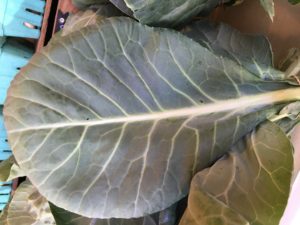» Jump to recipes using Collard Greens as an ingredient
Collard Greens
Collard Greens are grown for both edible and ornamental purposes. These plants have large, flat, dark green leaves with a fibrous stem growing through their center. They are in the same family as cabbage and broccoli, the brassica family.
Collard greens are very tough and therefore need to have a long cooking time and are often boiled to break down their fibers. They can also be sautéed or steamed. Collard greens are too tough and hard to digest when eaten raw.
Collard greens hold up very well in the freezer by simply removing their stem, blanch them, cool them, and freeze in bags. (See below)
From Jamie- “Our leafy greens are never sprayed with any “smart fresh” or preservatives so they require a little different handling than some of their siblings you may have come across in the past.
Knowing how to properly store and preserve the items in your farm share will allow you to make the most out of your share and your investment. Take advantage of the simple and helpful tips that we pass along with the arrival of new crops and you will make sure no veggie goes to waste!
1. De-stem or de-vein and wash when you get your share home
2. Let drip-dry for a few minutes in your strainer or on your counter top.
3. Lay each leaf out and stack
4. Carefully place in a damp paper towel and place in a large zip-lock bag
5. Store in your fridge until you are ready to use.
Your greens will last 5-7 days if properly stored this way!”
Collard greens are a great way to get Vitamin A,C,K and contain calcium, vitamin B6, and manganese
These collards were steamed up by Jess’ good friend Larry, who steamed one bunch for about 20 minutes and tossed with salad dressing. The second bunch was sauteed with a bit of garlic. 



Overwhelmed with greens in your share? During the influx of seasonal greens, Jess usually starts a pot of boiling water after she gets home. After going over the meal plan for the week, fill a big bowl with ice and water and clean the veggies you’ll be freezing while waiting for the large pot of water to boil. Meanwhile, visit this website from the National Center for Home Preservation or a similar website to be reminded of blanching times for each veggie. Next, send each prepared veggie through the boiling water for it’s allotted time, then into the ice water to stop the cooking process. Next it’s into the colander to drain, then into the freezer bags (or a FoodSaver if you’ve got one). Once the water is boiling, everything moves very quickly, quite like an assembly line. Unless you’re doing a major amount of veggies, you don’t have to change the boiling or blanching water in between veggies.  Though you may be growing weary of the abundance of certain veggies at present, they can definitely be a sight for sore eyes during the winter months!
Though you may be growing weary of the abundance of certain veggies at present, they can definitely be a sight for sore eyes during the winter months!
Recipes Using Collard Greens
Got bacon and collards? Why not try this Kickin’ Collard Greens recipe? Though it was good, I recommend leaving out the red pepper flakes until the end and let folks season to taste themselves. I love spicy food, but the red pepper flakes against the smoky bacon flavor of the collards was a bit overpowering for me. I’ll try this one again as the rest of the flavors made for fine comfort food! Remember to have chicken broth on hand for this one!
The texture of these collard greens is pretty great and makes it versatile in many dishes. Noodling the greens very thinly allows you to achieve a texture during cooking that gets rid of the toughness of a collard leaf without cooking it into oblivion.









